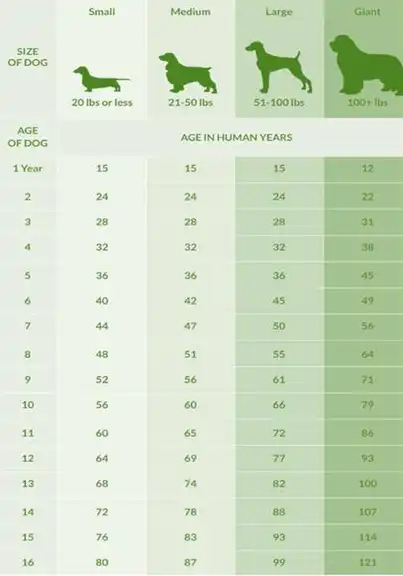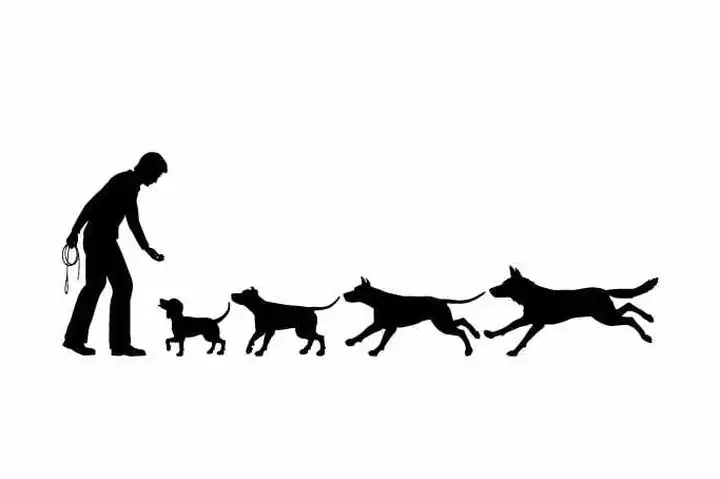How to Calculate Dog Years to Human Years – If you’re a dog lover, you’ve probably heard of the common belief that one dog year equals seven human years. However, this is only partially accurate, as the conversion of dog years to human years is more complex than that.
How to calculate dog years to human years
This article examines the various factors contributing to a dog’s and a human’s aging process, providing users with an in-depth guide on calculating dog years to human years.
Understanding the Aging Process of Dogs and Humans
For many years, the traditional approach to determining a dog’s age in human equivalents multiplied its chronological age by seven. This technique originated from the hypothesis that dogs mature at a rate equivalent to seven times faster than humans do. Nevertheless, this concept has been questioned and contested by veterinarians and animal behaviorists who believe it does not accurately portray the aging process in canines.
According to Dr. Danel Grimmett, a veterinarian at Sunset Veterinary Clinic in Oklahoma, genetics play a significant role in the aging process of dogs. Certain breeds of dogs are predisposed to specific health issues, which can affect their lifespan and quality of life as they age. For example, large breeds such as Great Danes and Mastiffs are more prone to joint problems, leading to arthritis and mobility issues in their senior years.

In addition to genetics, environmental factors such as nutrition and exercise can also affect the aging process of dogs. A study published in the Journal of Veterinary Internal Medicine found that dogs fed a calorie-restricted diet lived longer than those not. Regular exercise can help dogs maintain their physical and mental health as they age.
Similarly, the aging process of humans is also influenced by genetics, environment, and lifestyle factors. According to the American Psychological Association, genetics account for approximately 25% of the variation in the human lifespan. Environmental factors such as nutrition, exercise, and stress can also affect aging. A study published in the Journal of Gerontology found that older adults who engaged in regular exercise had a better cognitive function and less cognitive decline than those who were sedentary.
Comprehending the aspects that impact the aging process of dogs and humans is essential for providing appropriate care and maintaining their health and well-being as they age. By consulting with trusted sources such as veterinarians and animal behaviorists, pet owners can better understand their pets’ unique needs and provide them with the care they need to thrive in their senior years.
The Traditional Method of Calculating Dog Years to Human Years

The traditional way of estimating a dog’s age in human years was to bear the dog’s age by seven. This method is established on the assumption that dogs age at a rate of seven years for every human year. However, this method has been challenged by veterinarians and animal behaviorists who argue that it oversimplifies the aging process of dogs.
According to Dr. Kate Creevy, a veterinarian and associate professor at Texas A&M College of Veterinary Medicine and Biomedical Sciences, the traditional way of estimating dog years to human years needs to be revised. Creevy explains that the rate at which dogs’ age varies depending on their breed and size. For example, small dogs tend to have longer lifespans than larger breeds; therefore, they age more slowly.
Creevy and her colleagues developed a new method based on DNA methylation, which occurs as cells age, to calculate a dog’s age in human years precisely. Using this method, they created a chart that shows the equivalent human age for dogs of different ages and sizes.
The new method developed by Creevy and her colleagues is considered more accurate than the traditional method, as it considers the unique characteristics of each dog’s breed and size. It also provides a more realistic view of the aging process of dogs, which can help pet owners make informed decisions about their care.
While the traditional method of calculating dog years to human years may vary widely in the past, it is not considered an accurate reflection of a dog’s age. By consulting with trusted sources such as veterinarians and animal behaviorists, pet owners can better understand their pet’s ages and provide appropriate care and attention as they age.
The New Method of Calculating Dog Years to Human Years

The traditional method of estimating a dog’s age in human years has long been considered flawed, as it needs to be more precise in the aging method of dogs. As a result, veterinarians and animal behaviorists have developed a new method based on DNA methylation, which occurs as cells age. This new method is more precise and considers the unique characteristics of each dog’s breed and size.
Dr. Kate Creevy and her colleagues developed the new method at Texas A&M College of Veterinary Medicine and Biomedical Sciences. They analyzed DNA methylation patterns in dogs to create a chart that shows the exact human age for dogs of various ages and sizes. The chart considers that dogs age more rapidly in their early years and then slow down as they age.
The chart also shows that small dogs live longer than larger breeds and age more gradually.
An example of this could be that a small dog at one year old is equivalent to a 31-year-old human, while an older large canine would have the same developmental stage as a 46-year-old person.
It said that a 10-year-old small dog is equivalent in age to someone who is 56 years old, and if it were instead a large dog of the same age, then its human counterpart would
The new method of calculating dog years to human years is considered more accurate than the traditional method, as it considers the unique characteristics of each dog’s breed and size. It can help pet owners better understand their pet’s ages and provide them with appropriate care and attention as they age.
The new method of calculating dog years to human years based on DNA methylation patterns accurately reflects a dog’s age. Pet owners can consult with trusted sources such as veterinarians and animal behaviorists to better understand their pet’s ages and provide appropriate care as they age.
Common Myths and Misconceptions About Dog Aging
Pet owners should know several common myths and misconceptions about dog aging. Some of these myths are established on outdated information or misunderstandings about the aging procedure of dogs. Understanding these myths and misconceptions is vital so pet owners can give their dogs appropriate care and attention as they age.
Myth #1: All dogs age at the same rate.
It is one of the most common myths about dog aging. In reality, the rate at which dogs’ age varies, counting on their breed, size, and individual characteristics. Small dogs have longer lifespans than larger breeds, so they age more slowly.
Myth #2: One dog year is equal to seven human years.
As discussed earlier, this is a widely held myth established on the traditional method of estimating dog years to human years. However, this method needs to be more precise and oversimplifies the aging method of dogs.
Myth #3: Old dogs cannot learn new tricks.
This myth is based on the idea that older dogs are less adaptable than younger dogs. In reality, older dogs can learn new things, and many continue to be active and engaged well into their senior years.
Myth #4: Dogs don’t need as much exercise as they age.
While it is true that older dogs may not be able to exercise as vigorously as they did when they were younger, they still need regular exercise to maintain their health and well-being. Regular exercise can help older dogs maintain mobility, reduce the risk of obesity, and improve their overall quality of life.
Myth #5: All senior dogs have health problems.
While it is true that older dogs are more likely to develop health problems, not all senior dogs have health issues. Regular check-ups with a veterinarian can help identify any health problems early on, allowing for timely treatment.
Understanding the common myths and misconceptions about dog aging can assist pet owners in feeding their dogs with appropriate care and attention as they age. It is necessary to consult with trusted sources such as veterinarians and animal behaviorists to understand dogs’ aging procedures competently and give the best potential maintenance.
The Importance of Aging Care for Dogs and Humans

As dogs and humans age, they require specific care to maintain their health and well-being. Aging care for dogs and humans involves a combination of physical and mental health support, including routine check-ups with healthcare providers, proper nutrition, exercise, and mental stimulation.
Aging care is especially important for dogs because they age more quickly than humans. As dogs reach their senior years, they become more susceptible to health issues such as arthritis, dental problems, and cognitive decline. Pet owners must monitor their dogs for any changes in behavior or health and take them for regular check-ups with a veterinarian to catch any potential health issues early on.
In addition to physical health support, dogs also benefit from mental stimulation as they age. Interactive toys, puzzle feeders, and training sessions can help keep their minds sharp and engaged.
Also, aging care for humans involves routine check-ups with healthcare providers to monitor for potential health issues and maintain a healthy diet and exercise routine. Mental stimulation is also important for humans, and activities such as reading, puzzles, and social engagement can help maintain cognitive function.
Research has shown that owning a pet can have several health benefits for humans, including reduced stress and improved mental health. Pet owners must provide their dogs with proper aging care to ensure they can continue to enjoy a happy and healthy life together.
Aging care is important for dogs and humans to maintain physical and mental health as they age. Pet owners must consult trusted sources such as veterinarians and animal behaviorists about developing an appropriate aging care plan for their dogs. Similarly, humans should consult healthcare providers about developing a healthy aging care plan with physical and mental health support.
How to determine a dog’s breed in their lifespan and aging process?
Determining a dog’s breed can be challenging, but it is essential to understand as breed plays a significant role in their lifespan and aging process. Different breeds have unique characteristics, temperaments, and health issues; awareness of them can help pet owners take better care of their furry friends. This article will discuss how to determine a dog’s breed and why it is crucial for its overall health.
Physical Characteristics
The easiest way to determine a dog’s breed is to look at its physical characteristics. Different breeds have specific physical traits that set them apart from others. For instance, if a dog has a short, flat coat, a wrinkled face, and a pushed-in nose, it is likely a bulldog. Similarly, a dog with long, silky hair, a lean body, and pointed ears is likely a German Shepherd.
Some breeds have unique physical characteristics that are not found in others, such as the Dalmatian’s spots or the Basset Hound’s long ears. However, remember that some mixed-breed dogs can also have unique physical characteristics inherited from their parent breeds.
DNA Testing
DNA testing is becoming increasingly popular among pet owners to determine their dog’s breed. DNA testing involves taking a cheek swab from the dog and sending it to a lab for analysis. The lab will then compare the dog’s DNA to a database of known breeds to determine its genetic makeup.
Although DNA testing is not 100% accurate, it can provide valuable information about a dog’s breed and potential health issues. This information can help pet owners take preventive measures and make informed decisions about their dog’s care.
Behavior and Temperament
Another way to determine a dog’s breed is by observing its behavior and temperament. Different breeds have distinct behavior patterns and temperaments that reflect their genetic makeup. For instance, Border Collies are known for their intelligence and herding instincts, while Labrador Retrievers are known for their friendly and loyal nature.
If a dog exhibits certain behaviors or personality traits, it can provide clues about its breed. However, remember that behavior and temperament can also be influenced by training, socialization, and environment.
Why Knowing a Dog’s Breed is Important
Knowing a dog’s breed is important for several reasons.
- First, it can help pet owners understand their dog’s unique health needs. Different breeds are predisposed to certain health issues, and awareness of them can help pet owners take preventive measures and seek timely medical care.
- Second, knowing a dog’s breed can help pet owners understand their behavior and temperament. Different breeds have different energy levels, exercise needs, and socialization requirements, and being aware of them can help pet owners provide appropriate care and training.
- Third, knowing a dog’s breed can help pet owners make informed decisions about adopting or purchasing a dog. Understanding a breed’s characteristics and temperament can help pet owners choose a dog that fits their lifestyle and personality well.
Determining a dog’s breed can be challenging, but it is essential for their overall health and well-being. Pet owners can use physical characteristics, DNA testing, and behavior and temperament to identify their dog’s breed. By knowing their dog’s breed, pet owners can provide appropriate care, seek timely medical attention, and make informed decisions about their pet’s future.
Conclusion
How to calculate dog years to human years – It is essential to comprehend the aging process of both dogs and humans to give appropriate care as they age. The traditional technique of correlating dog years with human ones, which proposed that a single canine year was akin to seven human years, has been invalidated by the novel approach – this considers factors such as breed and size.
There exist various myths and misconceptions about the aging process of dogs, for example, that one dog year is equivalent to seven human years. These wrong ideas can lead to inaccurate assumptions regarding their physical health and emotional well-being.
Providing proper aging care for humans and dogs, involving physical and mental health support, is imperative. It includes frequent check-ups, proper diet, exercise, as well as providing stimulation mentally. Ensuring the appropriate aging care for dogs and people guarantees their overall health and satisfaction during old age.
It is of paramount importance to comprehend the aging process in both humans and canines, dismiss any inaccurate beliefs or misunderstandings, and offer appropriate elderly care for safeguarding the healthiness and contentment of people as well as pooches.
Pet owners and medical practitioners should confer with reliable resources, including veterinarians and animal behaviorists, to create an adequate aging care plan for their canines and themselves. If the correct steps are taken regarding elderly care management, dogs and humans alike can experience a contented life together.


